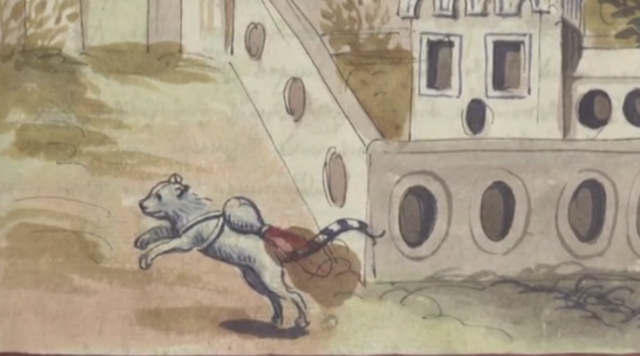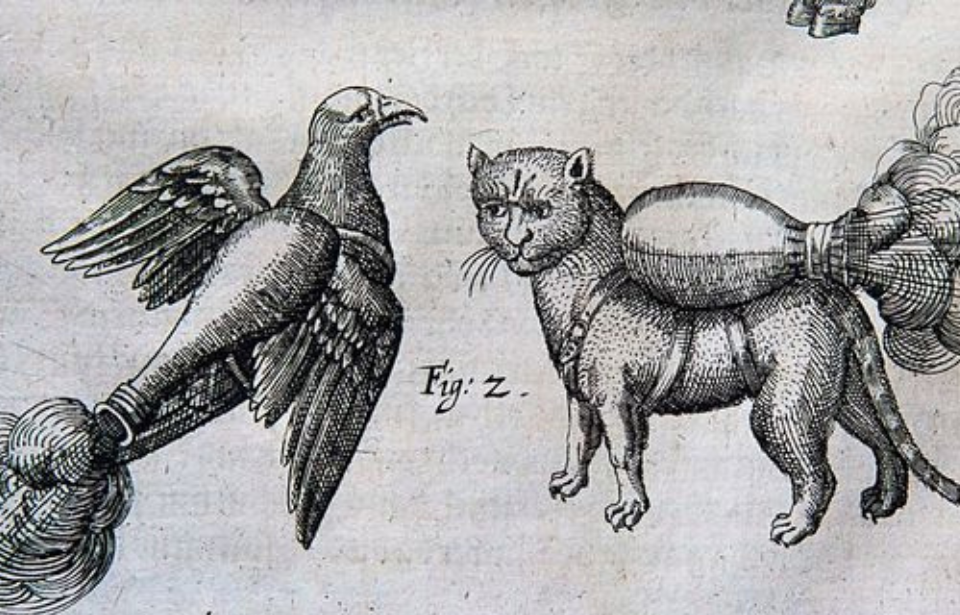The Medieval era is known for its unique takes on just about everything. From strange hygiene habits to medical practices, it was certainly a different time. Armies from the period were known to make use of rather barbaric and strange warfare tactics, and the weirdest was without a doubt 16th-century rocket cats.
Franz Helm

The person behind rocket cats was Franz Helm, an artillery master from Cologne, Germany. He fought for Holy Roman Emperor Charles V in his fight against the Ottoman Empire, and would later go on to serve Dukes Albert V, Louis X and William IV in the Duchy of Bavaria.
Helm wrote a treatise on siege warfare, Buch von den probierten Künsten, based on his experiences in battle. While not published until 1625, the manuscript was widely spread and became well-known in the Germanic territories.
The tactics described played on pre-existing artillery and siege weapon designs, including missile-like explosives studded with spikes and a spiked ramming device with the ability to burst into flames. The most interesting, however, was the idea of rocket cats and birds, wherein an incendiary device is attached to them.
Setting structures ablaze

Modern day historians weren’t sure of the purpose of rocket cats until Franz Helm’s manuscript was examined by Mitch Fraas, The director of special collections & research services at the University of Pennsylvania, he translated the text and provided an insight into the rather unique warfare tactic.
Under a section titled, “To set fire to a castle or city which you can’t get at otherwise,” Helm detailed how to use a rocket cat to set fire to enemy positions by attaching an incendiary to its back and setting it loose.
It reads, “Create a small sack like a fire-arrow […] If you would like to get a town or castle, seek to obtain a cat from that place. And bind the sack to the back of the cat, ignite it, let it glow well and thereafter let the cat go, so it runs to the nearest castle or town, and out of fear it thinks to hide itself where it ends up in a barn hay or straw it will be ignited.”
While the idea of using cats may seem strange, it’s theorized their use is associated with the religious attitudes of the time. They were often associated with the Devil and witchcraft, eliciting mistrust and anxiety.
Did rocket cats actually see use?

There’s no way to know for sure if rocket cats were actually used in battle. According to Mitch Fraas, it’s unlikely they saw action, calling the idea “a harebrained scheme” that would have backfired.
While Franz Helm is considered to be the creator of rocket cats, he wasn’t the first to mix animals with fire. The idea can be traced back to Biblical times with Samson, who’s said to have attached flaming torches to the tails of 300 foxes, which were then let loose to burn the fields of the Philistines.
The Chinese were also known to use this tactic. In 1188, the Song Dynasty set oxen on fire to burn down bridges. On top of this, a military manual from 1000 discusses the concept of firebirds, wherein they attached a hollowed-out peach pit filled with mugwort tinder to the necks of wild pheasants.
The most famous use comes from Olga of Kiev during the 10th century AD. She sought to exact revenge against the village of Iskorosten and accomplished this by demanding the residents provide her with three sparrows and three doves. She attached smouldering embers to them and set them loose. The village quickly went up in flames when they flew home.
Animals and warfare

The concept of using animals in warfare is nothing new. Throughout history, armies have used all types of species to bulk up their numbers, with varying degrees of success.
The origins of war elephants is disputed. They were an integral part of Indian kings’ armies around the 4th century and their use subsequently spread to the Persian Empire. As their use increased, so, too, did anti-elephant tactics. A form of defense was to let loose squealing pigs, as the elephants were scared of them.
Before tanks were developed, armies used rhinos. There’s evidence Portuguese soldiers used them to counter war elephants, while the Ahoms – the people of Assam in Northeast India – would use intoxicated rhinos to run through enemy lines.
Dogs have long been used in warfare. They saw action with the ancient Egyptians, Greeks and Romans, along with the nations fighting during World War I and II. The Romans trained the Molossian dog and outfitted it with armor, as did Attila the Hun, while Spanish conquistadors used armored dogs to kill their enemies during their invasion of South America.
More from us: Sergeant Stubby: The Most Decorated War Dog of World War I
Want to become a trivia master? Sign up for our War History Fact of the Day newsletter!
During the Second World War, both the Japanese and Soviets used dogs. The tactic, however, didn’t succeed. The Japanese and their canine companions were quickly defeated by Allied troops. The Soviets used dogs to carry bombs under German tanks, but found the noise caused them to run away.
